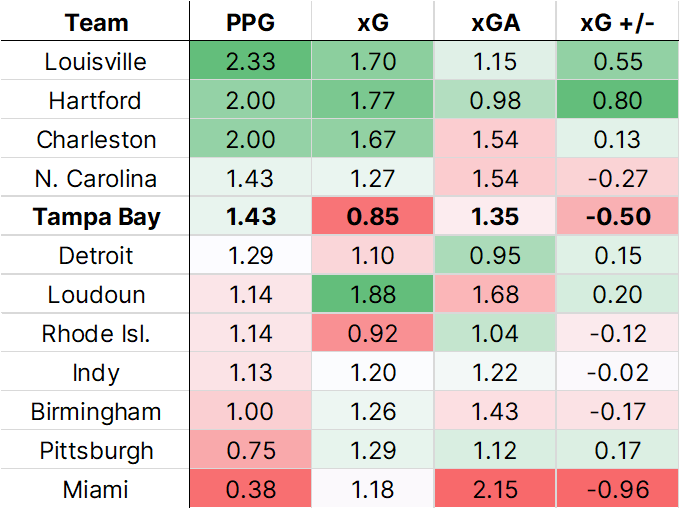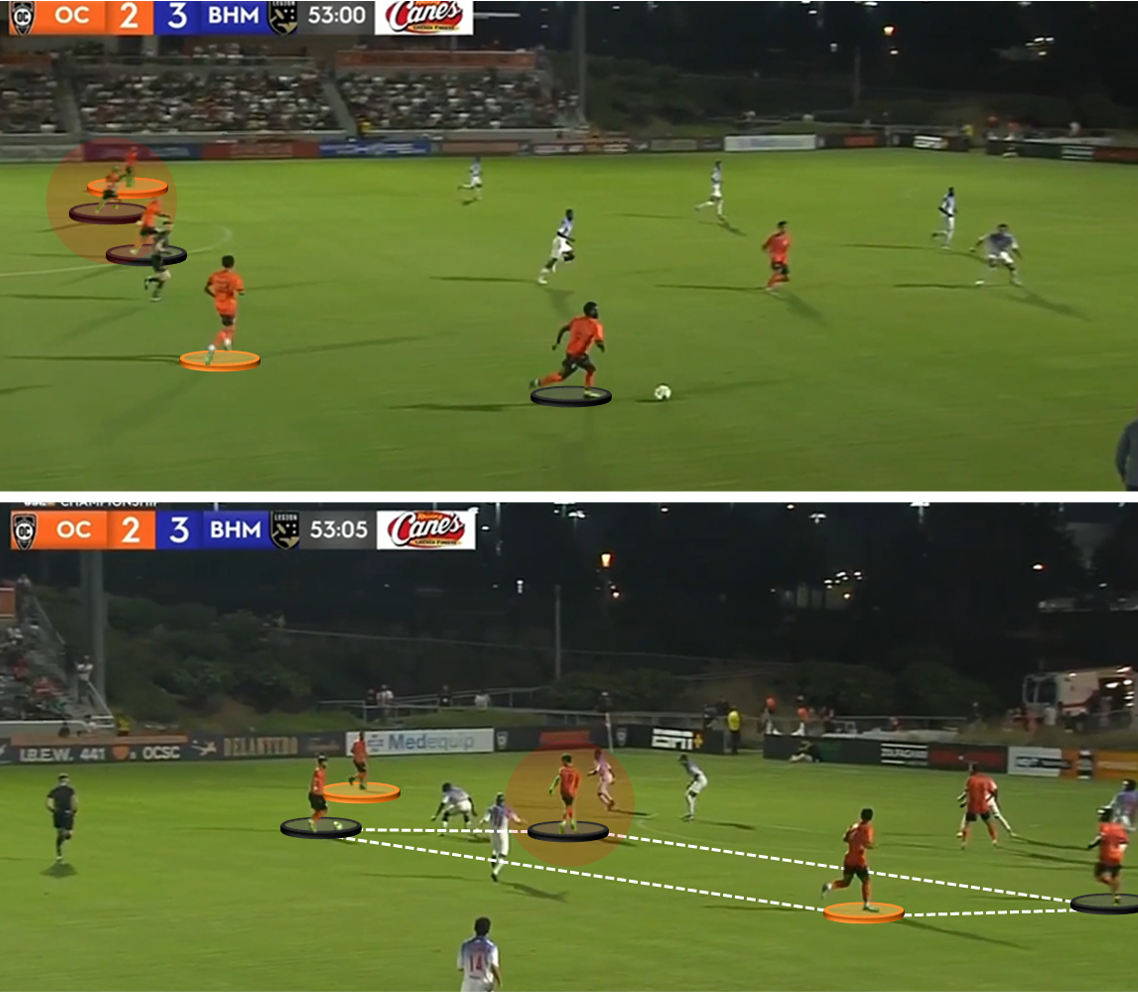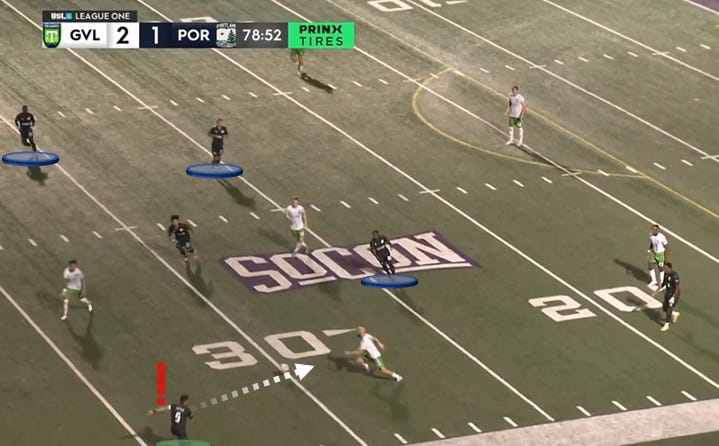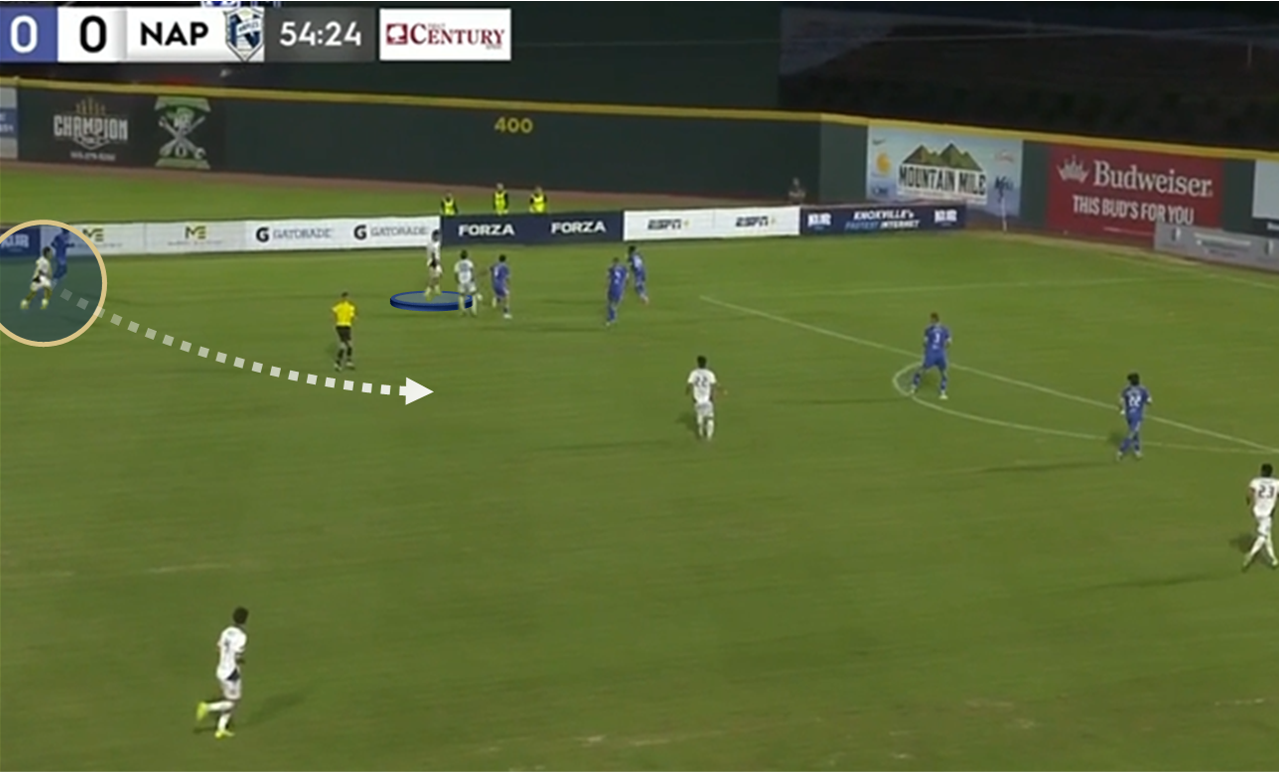The Back Four: Yes, it's a new newsletter
On posting schedules, plus Tampa Bay, Portland, and more USL miscellany
Welcome in to The Back Four!
Yes, it’s Friday. Yes, you’re getting this newsletter again. As a guy with an actual non-writing job to balance, I need to tweak the schedule a bit, so bear with me as this becomes a Friday article.
As always, check out Backheeled for more USL content, including this week’s examination of D1 compliance and Pittsburgh’s stadium project. You can also find This League! for an audiovisual dive into the week that was.
Without further ado, let’s get to it.
Resurgent Rowdies?
Have the Rowdies improved since Dom Casciato took over? It depends what numbers you consult, and it seems to vary between halves of a given match.
By points per game, Tampa Bay has performed like a top-four team in the East in the Casciato era, firmly in the mix for a home playoff match. By xG, however, only Miami has been worse. Tampa Bay often starts matches slowly (bad!) but finishes them successfully because of Casciato’s well-considered substitutions and tactical changes (good!). It’s a story of contrasts.
Where does that leave us? The underlying xG numbers – East-worst offensive production and middling defensive returns – paint the outline of the picture. For my money, it’s Tampa Bay’s inconsistent ability to stay in the final third that’s holding them back. When the Rowdies waste chances close to goal, it inherently allows the opposition to go to work.
Since July 11th, the Rowdies have taken the least touches in the box (12.4) in the USL on a per-game basis. For every entry into the final third, this team plays just 1.7 passes in that zone – fifth-from-bottom in the Championship and evidential of that wastefulness.
The bright side? Tampa Bay has limited transition opportunities for their opponents even after the giveaways. They’ve allowed just 0.57 fast break shots and 0.13 fast break xG per match under Casciato, both top-third marks in the Championship. This team is shapely in recovery and, as we’ll see, is finding their footing in the counterpress.
Still, this team’s Achilles’ heel comes in more conventional defensive scenarios. No team wins the ball in the final third less often, and that press-light approach – often manifested in a mid-low 5-3-1-1 formation – is giving rival clubs far too much room to work.
Consider the sequence here from a recent draw against Phoenix Rising. The guests possess around halfway, with 10 players behind the ball for Tampa Bay. However, that abundance of deep-seated defenders doesn’t lead to any actual ball pressure. The Rowdies sit narrow, and the way they compress their back five opens up a lane up their left sideline.
These sorts of issues were rampant over the weekend against Pittsburgh, at least for 45 minutes. There, Tampa Bay conceded in the third minute in a very similar situation to the one we’re seeing above. The difference? Pittsburgh used the light pressure to drive toward the right channel, where wingback-winger interchange went unchallenged and allowed the Riverhounds to slice into the box.
In that first half, Tampa Bay gave up a humongous 20 touches in their box. They attempted just two tackles and won only 12 of 35 total duels. Everything felt wrong, and a midfield with Danny Crisostomo as the primary destroyer and Luis Alvarez as that line-splitting second striker in the 5-3-1-1 felt overmatched and outgunned.
Fast forward 45 minutes, and Tampa Bay found themselves 2-1 winners by reversing all of those trends. The Rowdies essentially fought to a 50/50 stalemate on duels and took 66% more box touches than their guests in the second half. The changes that made it happen came in waves, but Manuel Arteaga’s introduction into the front line was essential.
2025 has been the most inconsistent season in Arteaga’s USL career, but he brought it against Pittsburgh. His entrance created more of a 5-3-2ish press, but his real value came in possession. In contrast to Alvarez, Arteaga combined defense-challenging movement with an anchor-like ability to hold play up. He led all players with nine duel wins despite playing just 45 minutes.
You’re seeing his utility above. As Tampa Bay builds upfield, they quickly break lines before Pittsburgh can settle. Arteaga is able to receive with pressure on his back, turning into space and further unsettling the defense.
While the No. 9’s through pass toward an overlapping Blake Bodily goes incomplete, the idea is great. Moreover, the response after the incompletion is stellar.
Tampa Bay’s counterpress swarms; Arteaga gets involved, Lewis Hilton slides over, and Aaron Guillen wisely applies himself out of the left-sided center back spot to fill for Bodily. As such, the Riverhounds don’t have an easy way to access the center of the pitch or break with any sense of control. A risky chip goes incomplete, allowing the Rowdies to snuff out a potential counter.
This level of team-wide organization and defensive aggression will be familiar for those who watched Casciato’s Union Omaha teams. Likewise, Arteaga’s role echoed what we saw of Steevan Dos Santos – himself a former Tampa Bay star – within the Casciato tactical framework.
Things only got better late-on, when Paul Marie moved into the midfield, adding a far greater sense of between-the-lines gumption than either Lewis Hilton or Laurence Wyke did as the No. 8s. You’re seeing the San Jose loanee on the ball here, carving behind the opposing midfield. Arteaga and Woobens Pacius draw the defense tight, opening room on the overlap for Nick Moon (another sub) that Marie will leverage with a slick rightward pass.
These sorts of sequences (i.e., possessive line breaks into the final third with strong numbers) have been too rare. In the Casciato era, this team has attempted just 73 passes in the attacking third per game. We mentioned the lack of box penetration up top, and no team in the USL tries less open-play crosses than Tampa Bay.
Whether Marie sticks in the midfield or remains the starting right wingback – he changed roles around the 60th minute against Pittsburgh – you’re seeing the blueprint start to come together. Tampa Bay is figuring out their defensive model, finding more consistent patterns to break into the final third, and getting aggressive where it counts.
As it stands, my numbers give the Rowdies a mere 27% chance of making the postseason. That’s low, but it’s far from an impossibility. If Casciato can replicate what we saw against the ‘Hounds, this team could be a legitimate dark horse.
Pedro Guimaraes’ versatility
As shouted out in the league’s Young Player Spotlight column earlier this week, Pedro Guimaraes shifted into the midfield last weekend and helped fuel a four-goal outburst against Birmingham. What’s fascinating is how Guimaraes’ role has shifted over the course of 2025.
Through all of March, the teenager started at left back as Ryan Doghman pushed ahead as the left winger. Against the Legion, that relationship flipped. Guimaraes started in a more advanced position and often tucked inside like a pseudo-No. 8 in order to open up overlapping opportunities for Doghman. By contrast, their paired starts back in March often saw Guimaraes focus on underlapping movement as he ran high from the back four.
In recent weeks and months, Orange County has defended in a 4-2-3-1 but attacked with far more fluidity. Designed imbalances have been common. You’ll usually see the left winger tuck in to free Doghman; the right back stays comparatively low and narrow. That arrangement held over the weekend, even with the 17-year-old Guimaraes on the flank.
Danny Stone’s system gives OCSC flexibility in numerous situations. Here, you see a breakout situation where Ousmane Sylla – the starting No. 10 – serves as the initial ball carrier. Guimaraes, meanwhile, is indicated in red as he advances up the weak side.
As Orange County advances, striker Ethan Zubak pushes toward the net and forces the opposing defense back. Meanwhile, Sylla uses that additional space to dish toward Chris Hegardt. Often used as the tucked-in left-sider, Hegardt played as a No. 8 over the weekend and unselfishly sat back behind Guimaraes in numerous situations.
Here, that construction essentially puts Orange County into a “three-box-three” in the final third. Guimaraes, Hegardt, Sylla, and right back Nicola Ciotta form that four-man box up the middle, whilst Doghman and right winger Bryce Jamison provide the width.
The surfeit of central numbers throw the Legion out of whack, and this sequence will end with Guimaraes scoring from the edge of the box.
It’s a familiar pattern, but the flexibility stands out. Usually, Ciotta is the one to sit deep and essentially give Orange County three rest defenders. Here, though, he’s operating like a center mid while Nico Benalcazar does the dirty work out of frame.
Of course, there’s the Guimaraes piece to consider. Beyond the finish here, the teenager got an assist, went 51/55 as a passer (including nine final-third entries), and made five ball recoveries. You’d never have known he was transitioning out of his natural spot into a tactically complex wing position.
Compared to all other fullbacks and midfielders across 2025, Guimaraes has been nothing but solid. He’s an active defender with a real sense of progressivity to his passing game. The teenager has rarely been tasked with hitting the final ball close to goal, but he’s smart enough as a runner to take up good positions near the 18-yard box and free his teammates to do the damage.
Fascinatingly, games where Guimaraes starts see Orange County hold 56.5% of possession on average. That number is merely 47.6% when he’s out of the lineup. Weird game states can muddy the statistical waters in a small sample, but it’s clear that Guimaraes has the skill and flexibility to meaningfully improve OCSC as a ball-controlling side. How he continues to blossom at Championship Soccer Stadium will be fascinating to see for the rest of 2025.
Nitpicking Portland
If you’re a Portland Hearts of Pine supporter, this is the sort of play you like to see:
For one, Bobby Murphy’s side is the aggressor with the ball, the team that’s dictating where the match is played. This clip elides a vertical pass into the attacking zone, but it’s emblematic of a Hearts of Pine side whose average pass travels 8.6 yards upfield, 21% of the League One median. While striker Noah Kvifte can’t hold the ball in this instance, his side is still setting the terms.
When the expansion side turns over, the response is fierce. Mikey Lopez steps up from the pivot to charge at the ball, and right back Sean Vinberg hedges his bets to potentially close down. Portland is the only team in League One to take the ball away in the final third 4.0 times per match or more, and you’re getting a hint of that intensity.
While opposing Charlotte gets out on the break, they don’t have free rein to do so. Even when the Independence are seemingly out in the open, they’re facing down three set defenders (two center backs and left back Nathan Messer) as well as a recovering Michel Poon-Angeron.
You know the rest. Portland gets a stop, immediately looks long upfield, and goes right back to work. This Independence game saw Hearts of Pine dominate in the liminal moments – and set themselves up in those fluid, transitional situations.
Sega Coulibaly and Kemali Green, the starting center backs, were extremely direct and led the team in final-third entries. Even when the long balls didn’t hit, Portland put up a season-high seven takeaways in the final third, evidential of their killer counterpress. Portland posted nearly 0.8 fastbreak xG, a gargantuan sum. Ollie Wright dominated, Vinberg came good, and a 4-2 rout was the result.
By contrast, Wednesday’s matchup against the Greenville Triumph was a different beast. Greenville pressed far harder than Charlotte, setting a firm line of confrontation not too far off from halfway. That high pressure limited the openness of the pitch, put a cap on Portland’s verticality, and made for a fascinating matchup.
Off of restarts, Triumph played short at the back within 4-2-4ish offensive system, pinning their center mids and fullbacks deep to draw Portland’s midfield line high. Doing so created separation, forcing Hearts of Pine to cleave a gap between their defense and the rest of the press.
When that space opened, Greenville often tried to hit longer passes over Murphy’s 4-4-2, targeting Messer in the process. The left back had to deal with an individual matchup against Pascal Corvino, but he was often doubled-up against by way of Evan Lee’s diagonal movement from the second striker(ish) spot in the Triumph shape.
That’s not to say that Portland was bad, but their usual preferences weren’t on the menu thanks to Greenville’s hyper-targeted attack. Hearts of Pine struggled to speed the game up to their tempo; the home team chose when to push down on the accelerator.
If you’re wondering: yes, I’m being overly harsh. Portland went down to 10 men and still beat Greenville! Messer got the tying assist! That equalizing move actually started with a hard closedown from Mikey Lopez at right back…
…that was virtually identical to the one we saw from Vinberg at the start of this screed.
The moral of the story? Portland has their vulnerabilities – particularly against a team as dynamic as Greenville – but they’re never on the mat for long.
As the game progressed on Wednesday night, Hearts of Pine did what they do best. The press began to speed Greenville up, limiting their ability to pick out long balls. In the first 45 minutes, the Triumph played 80 passes in their half and completed 88% of them; that number crumbled to 47 on a mere 78% completion rate in the second period. In possession, Portland trusted the process by leaning into a red-hot Masashi Wada in tight spaces.
I’m harsh about Hearts of Pine because their potential is so obvious. No team in League One is as vivacious as Portland at their best, and they’ve continued to add talent or re-position it (think Kvifte, Coulibaly, or even Vinberg) in a manner that’ll help amidst the playoff push. Clean things up just a bit, and the sky is the limit at Fitzpatrick Stadium.
Julian Cisneros, one of my favorite guys
There are certain USL players that I love watching play. They run from the obviously dominant (Juan David Torres, Nil Vinyals, Jack Gurr) to the subtle and classy (Declan Watters, Sofiane Djeffal). In his first USL season with FC Naples, fullback Julian Cisneros has quickly established himself as part of that crowd.
Cisneros’ profile doesn’t necessarily pop by the numbers. He’s got two goals and no assists thus far on 41st percentile xG and 20th percentile xA. As compared to other League One fullbacks, he’s in the bottom half in terms of touches per game. The rookie, who played at Loyola-Chicago and spent time with the Des Moines Menace during the NCAA offseason, makes up for it with energetic verve: he’s winning nearly seven duels a game and attempting more than three dribbles per match.
Whatever the numbers say, Cisneros catches your eye because he’s a relatively rare mold of player: a right-footed left back. I talk a lot about Akeem Ward because he fits the same bill, and Cisneros has quickly become a favorite because he brings a Ward-like quality to the table.
Whether he’s cooking you on the dribble…
…or locking a winger down in a one-on-one…
…or using his movement to threaten open spaces…
…the Naples fullback has been a key contributor for the cream of 2025’s League One expansion crop.
Indeed, Matt Poland’s club is just one of two newcomers (Portland being the other) to post a positive xG margin to date. Much of that success owes to the brilliance of Jake Dengler and Brecc Evans at the back, but there’s a real balance between defensive solidity and the aggression underlined by Cisneros’ game.
Likewise, it’s easy to fixate on Karsen Henderlong’s scoring, but the wonky fullback play behind him is a real engine behind Naples’ transition success. This is a team with a gravitational No. 9, yes, but they back him up with tricksters. This club’s top-four dribblers have taken on opponents 178 times; only Portland’s leading dribblers have bettered that mark. Again, Cisneros is a trend-setter.
Put it all together, and FC Naples is likely to earn a home playoff match come October – a real achievement for an expansion organization. They’re doing so in style, and the identity of this team is reflected in Julian Cisneros’ wonky, aggressive, and dynamic game.
Quick Hits
In other news this week…
It occurred to me that I could’ve just waited until next Friday to post, but when life gives you the chance to write 3,000 more words about the USL…
I do not understand the Bolu Akinyode thing (i.e., Akinyode “mutually parting ways” on Thursday) in Miami? Like, I’m sure he’s probably going somewhere else in the Championship with legitimate title aspirations…but why would you let him walk for free if you’re a Miami team on the bubble?
Emiliano Terzaghi scored an utterly comedic goal at midweek, but I’m more interested in what he’s doing outside of the goalscoring. He’s averaging 10.1 duels per 90 minutes over his last three matches, up 14% on his season-average. His recoveries (+15%) and final-third passes (+20%) are also up. An involved Terzaghi is an effective Terzaghi.
Be sure to subscribe to my USL Show co-host Ryan Allen’s USL Odds newsletter, another Friday staple. It’s useful if you’re a bettor, but it also sets the stage for the weekend and is full of delightful stats – who else is comparing scoreless streaks to the runtime of the Star Wars prequels?
The Paper, the new spinoff of The Office on Peacock, is good. That’s largely because it feels like Parks & Rec instead of The Office.
Cover Photo Credit: the inimitable Morgan Tencza







